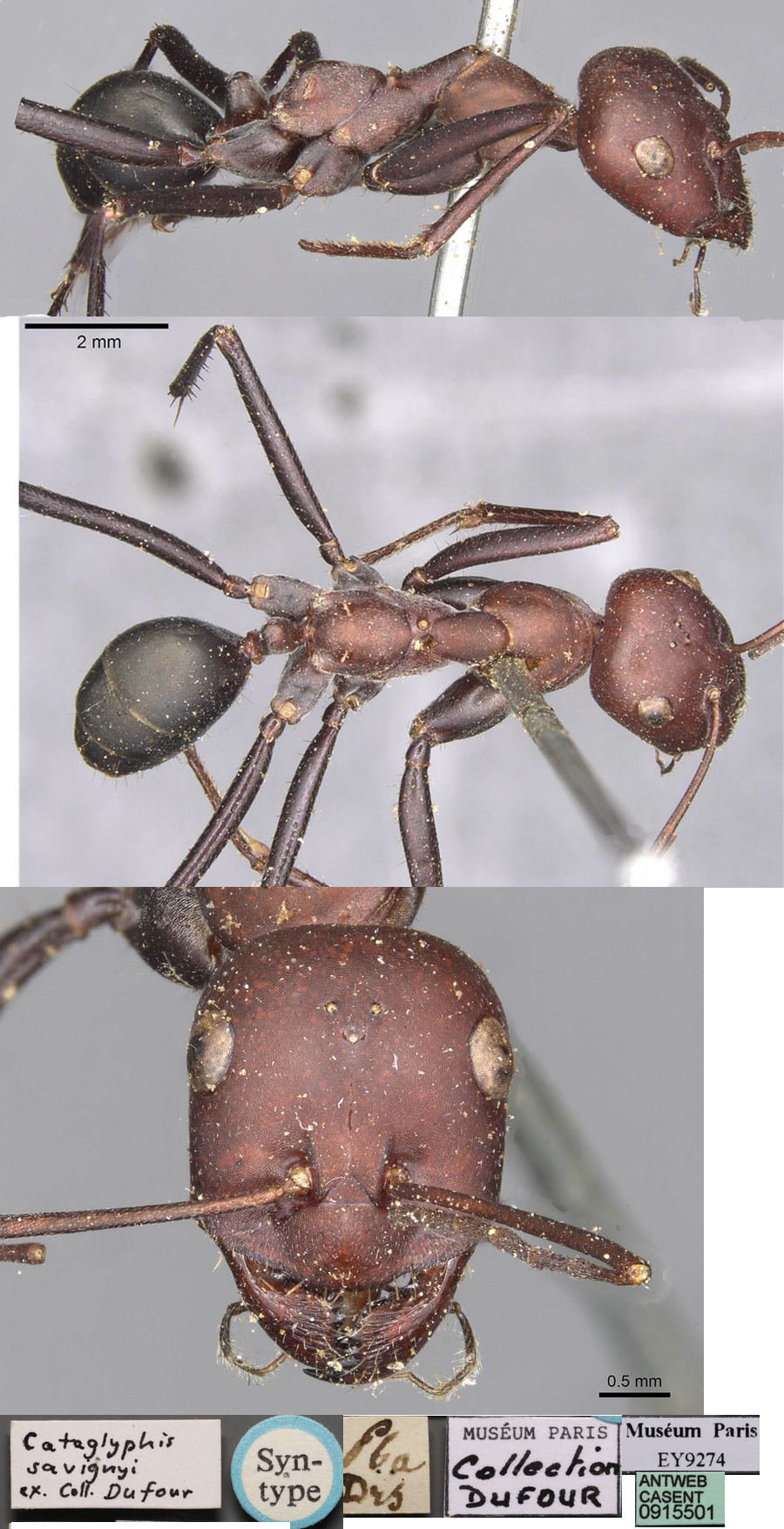Cataglyphis savignyi (Dufour)
  Type location Egypt (Formica
savignyi, Dufour, 1862: 141, worker & male; in Cataglyphis
Roger 1863b: 12; confirmed status Billen, 1989: 301; Agosti 1990a:
1490) - see below. Type location Egypt (Formica
savignyi, Dufour, 1862: 141, worker & male; in Cataglyphis
Roger 1863b: 12; confirmed status Billen, 1989: 301; Agosti 1990a:
1490) - see below.
|
Dufour's (1862) description is at  , with the worker as Fig 2 and the male as
Fig 1 from the Savignyi Plate 20. Santschi (1929b) gave a fresh
description (as Cataglyphis bicolor
F. stirps nodus v. savignyi Dufour) this is at , with the worker as Fig 2 and the male as
Fig 1 from the Savignyi Plate 20. Santschi (1929b) gave a fresh
description (as Cataglyphis bicolor
F. stirps nodus v. savignyi Dufour) this is at  . .
Agosti (1990a: 1490) appears to have decided
upon only the male, belonging to the bicolor species-group, as
being known under this name, worker specimens (from Gizeh) labelled as
the species belong to the alitisquamis species-group.
|
 Egypt
records - illustrated by Savigny (Audouin,
J.-V. 1825-27: Plate 20 Fig 2) and referred to by Dufour (1862). Note -
according to Agosti (1990a: 1490) the surviving workers in the Dufour
collection, in Paris, are of a Cataglyphis species within the mauritanicus
complex of the altisquamis species-group. Egypt
records - illustrated by Savigny (Audouin,
J.-V. 1825-27: Plate 20 Fig 2) and referred to by Dufour (1862). Note -
according to Agosti (1990a: 1490) the surviving workers in the Dufour
collection, in Paris, are of a Cataglyphis species within the mauritanicus
complex of the altisquamis species-group.
Santschi (1929b) noted a specimen in Paris collected
near the pyramids by Alluaud, the same location as Savigny's; Finzi
(1936: 192) reported several findings from northern Egypt - Alexandria,
Cairo, Heliopolis, etc. Billen (1989) studied workers collected near
their nest entrance at the base of fence walls surrounding the Faculty
of Science buildings at El Minya University, Egypt. He described it as
a desert ant which is active only during the heat of the day.
Sharaf list - Port Said, 26.viii.2003 (4); Salhyia,
17.iii.2002 (1); Elqasmia (Belbis), 21.ii.2003 (2); Nagh El-Ghalalab
(Aswan), 7.iii.2003 (12); Saloga Island (Aswan), 2.v.2002 (1); El-Sabah
Emarat, 50 km Ismailia-Cairo, 14.iii.2002 (1); Sallant (Daqahliya,
Egypt), 28.iii.2003 (3); Nagh El-Ghalalab (Aswan), 8.iii.2003 (1);
Hatshibsut temple (Luxor), 4.iii.2003 (4); Khniza (Nubaria), 21.ix.2002
(1); Wadi El-Rayan (Faiyum), 7.xi.2001 (2) (SHC).
|
 The
photomontage of a worker from the Dufour collection
is collated from http://www.antweb.org/specimen.do?name=casent0915501 The
photomontage of a worker from the Dufour collection
is collated from http://www.antweb.org/specimen.do?name=casent0915501
This poses something of a puzzle. The petiole and propodeum profile is not that of savignyi
as usually accepted, indeed, described by Dufour - who had petiole
characteristic and subglobose "gibbiforme" (humped). The size, however,
is not that of the largest worker, i.e. TL only ca 10.5mm, and thus it
may be a media worker.
|
 Wehner,
Wehner & Agosti (1994) established that savignyi
inhabits primarily dry sandy areas; variably alongside bicolor,
with the latter being predominant in agricultural soils. Wehner,
Wehner & Agosti (1994) established that savignyi
inhabits primarily dry sandy areas; variably alongside bicolor,
with the latter being predominant in agricultural soils.
See also Billen, J. 1989. Morphology of the cloacal
gland in the ant Cataglyphis savignyi. Actes des Colloques
Insectes Sociaux 5: 301-306.
|